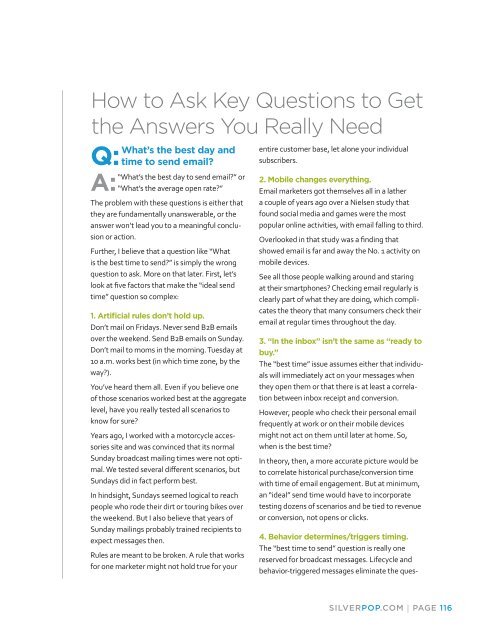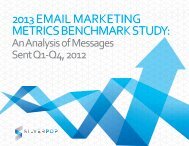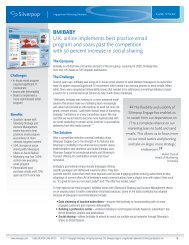eBook - Silverpop
eBook - Silverpop
eBook - Silverpop
You also want an ePaper? Increase the reach of your titles
YUMPU automatically turns print PDFs into web optimized ePapers that Google loves.
How to Ask Key Questions to Get<br />
the Answers You Really Need<br />
What’s the best day and<br />
Q: time to send email?<br />
“What’s the best day to send email?” or<br />
A:<br />
“What’s the average open rate?”<br />
The problem with these questions is either that<br />
they are fundamentally unanswerable, or the<br />
answer won’t lead you to a meaningful conclusion<br />
or action.<br />
Further, I believe that a question like “What<br />
is the best time to send?” is simply the wrong<br />
question to ask. More on that later. First, let’s<br />
look at five factors that make the “ideal send<br />
time” question so complex:<br />
1. Artificial rules don’t hold up.<br />
Don’t mail on Fridays. Never send B2B emails<br />
over the weekend. Send B2B emails on Sunday.<br />
Don’t mail to moms in the morning. Tuesday at<br />
10 a.m. works best (in which time zone, by the<br />
way?).<br />
You’ve heard them all. Even if you believe one<br />
of those scenarios worked best at the aggregate<br />
level, have you really tested all scenarios to<br />
know for sure?<br />
Years ago, I worked with a motorcycle accessories<br />
site and was convinced that its normal<br />
Sunday broadcast mailing times were not optimal.<br />
We tested several different scenarios, but<br />
Sundays did in fact perform best.<br />
In hindsight, Sundays seemed logical to reach<br />
people who rode their dirt or touring bikes over<br />
the weekend. But I also believe that years of<br />
Sunday mailings probably trained recipients to<br />
expect messages then.<br />
Rules are meant to be broken. A rule that works<br />
for one marketer might not hold true for your<br />
entire customer base, let alone your individual<br />
subscribers.<br />
2. Mobile changes everything.<br />
Email marketers got themselves all in a lather<br />
a couple of years ago over a Nielsen study that<br />
found social media and games were the most<br />
popular online activities, with email falling to third.<br />
Overlooked in that study was a finding that<br />
showed email is far and away the No. 1 activity on<br />
mobile devices.<br />
See all those people walking around and staring<br />
at their smartphones? Checking email regularly is<br />
clearly part of what they are doing, which complicates<br />
the theory that many consumers check their<br />
email at regular times throughout the day.<br />
3. “In the inbox” isn’t the same as “ready to<br />
buy.”<br />
The “best time” issue assumes either that individuals<br />
will immediately act on your messages when<br />
they open them or that there is at least a correlation<br />
between inbox receipt and conversion.<br />
However, people who check their personal email<br />
frequently at work or on their mobile devices<br />
might not act on them until later at home. So,<br />
when is the best time?<br />
In theory, then, a more accurate picture would be<br />
to correlate historical purchase/conversion time<br />
with time of email engagement. But at minimum,<br />
an “ideal” send time would have to incorporate<br />
testing dozens of scenarios and be tied to revenue<br />
or conversion, not opens or clicks.<br />
4. Behavior determines/triggers timing.<br />
The “best time to send” question is really one<br />
reserved for broadcast messages. Lifecycle and<br />
behavior-triggered messages eliminate the ques-<br />
SILVERPOP.COM | PAGE 116







